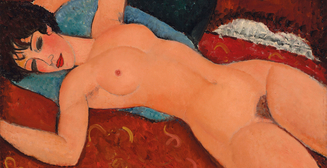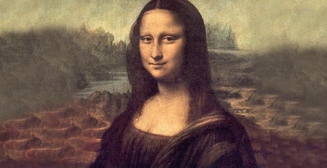В любом путешествии локальные музеи занимают едва ли не центральное место программы. Оно и немудрено: в Европе собралось огромное количество предметов искусства, истории и культуры (за пару-то тысячелетий!), в США правит бал современное искусство, а музеи помельче просто гордятся своими коллекциями и зазывают к себе.
Читай также: "Флаг", "Мост" и "Собака": 10 самых дорогих картин современных художников
Но пока что большинство стран ограничило туристические поездки из-за
эпидемии коронавируса , так что все мало-мальски культурные объекты вроде стадионов, музеев, театров и кино закрыты, а многие люди (в том числе селебы)
предпочли самоизолироваться .
И поскольку на сегодняшний день мы можем спасти мир просто сидя дома, на помощь спешит верный Интернет. Музейщики - люди вполне себе прогрессивные, поэтому их коллекции можно посмотреть онлайн, а по некоторым "сокровищницам" - даже прогуляться. Виртуально, естественно.
Британский музей, Лондон
Представь: ты сможешь увидеть самые значимые исторические ценности (не только Британии, если что)! И для этого даже не придется ехать на Туманный Альбион.
Рейксмюсеум, Амстердам
Полотна Рембрандта и многие другие шедевры теперь разве что потрогать нельзя. А разглядеть в деталях - пожалуйста.
Музей Соломона Гуггенхайма, Нью-Йорк
Ценителям современного искусства стоит отправиться на виртуальную экскурсию в Нью-Йоркский музей Гугенхайма - восторг гарантирован.
Национальная галерея искусства США, Вашингтон
Галерея проводит небольшие экскурсы в историю произведений даже в Instagram.
Национальный музей современного искусства, Сеул
Утонченные и необычные работы современных корейских творцов можно разглядеть даже на канале музея в Youtube.
Пергамский музей, Берлин
В богатой коллекции есть бюст Нефертити, великолепные ворота Иштар и множество других ценных реликвий.
Музей Ван Гога, Амстердам
Собрание работ художника, который отрезал себе ухо, привлекает внимание и ценителей, и просто интересующихся.
Музей Гетти, Лос-Анджелес
Здесь есть все - от античных статуй и средневековых гравюр до очень современных инсталляций и перфомансов.
Уффици, Флоренция
Произведения всех итальянских творцов эпохи Возрождения здесь.
Посмотреть эту публикацию в Instagram
#UffiziDecameron e il trionfo di Bacco! Che il #vino sia un alleato della seduzione è una storia antica quanto la bevanda cara a Dioniso. Dunque non ci racconta nulla di nuovo #AnnibaleCarracci, pittore emiliano, che in questo dipinto degli #Uffizi (1587ca) mette in scena il tentativo di seduzione da parte di un satiro ebbro nei confronti della dea della bellezza. Il personaggio del corteo di Bacco ha sul volto rubizzo un’espressione ammiccante, rafforzata dal verso boccaccesco del satiro bambino che abbraccia la gamba della dea e mostra la lingua. Ma Venere si ritrae cercando di coprirsi con il lenzuolo bianco simbolo di purezza, ribadito delle perle dell'acconciatura e dal monile con l’effige delle tre Grazie che indossa al polso. E i due piccoli della scena fanno il tifo per #Venere o per il satiro tentatore? Il vino farà il suo effetto e la bella cederà alle avance dell'improvvisato seduttore? La coppa d’uva nera e bianca, metafora del vino, sarà forse l’alleato necessario al satiro per far dimenticare alla bella il suo aspetto ferino...? • E N G 🌍 #UffiziDecameron and the triumph of Bacchus! #Wine as an helper of seduction: it is a long story as well as the story of Dionysus' favourite drink! This is what Annibale Carracci is telling us in this painting (1587 c.) where the faun is trying to allure no less than the goddess of beauty...! But she is pulling back, covering her naked body with a blank cover, symbol of purity, as the pearls she wears and the bracelet with the image of the Three Graces. And the kids, are they supporting #Venus or the faun's side? No doubts on the little satyr holding Venus' leg...! Is wine, symbolized by the white and black grapes in the cup that the satyr is offering to the goddess, going to be a mean to triumph over the resistance of Venus...?
Публикация от Gallerie degli Uffizi (@uffizigalleries) 17 Мар 2020 в 6:29 PDT
Посмотреть эту публикацию в Instagram
Sulla tomba di Raffaello nel Pantheon di Roma si legge questo epitaffio: “Ille hic est Raphael timuit quo sospite vinci, rerum magna parens et moriente mori”. (Qui giace quel Raffaello di cui la natura, mentre era vivo, ebbe timore d’esserne vinta e, mentre moriva, di morire con lui). Lo scrisse Pietro Bembo, amico carissimo di Raffaello, per rendere omaggio al grande pittore, morto, secondo alcune fonti, il 6 aprile di 500 anni fa, a soli 37 anni. Ed è proprio da questa data che inizia il percorso della mostra “RAFFAELLO. 1520-1483”, da oggi aperta al pubblico alle Scuderie del Quirinale fino al 2 giugno, ripercorrendo a ritroso tutta l’avventura creativa dell’artista fino alla giovinezza. Per la prima volta sono riunite circa 204 opere, di cui 49 provenienti dalle Gallerie degli Uffizi, delle quali oltre 30 dello stesso Raffaello. Dopo un delicato intervento di restauro durato tre anni e curato dall’Opificio delle Pietre Dure, è finalmente possibile ammirare uno dei capolavori del Maestro urbinate, il “Ritratto di Leone X”, il Papa che, insieme a Giulio II -anch’esso presente in mostra- furono i suoi mecenati e più importanti committenti #RaffaelloInMostra • 🌎ENG: In Rome, on Raphael’s tomb in the Pantheon, one can read a Latin epitaph written by famous Renaissance Italian poet Pietro Bembo, friend of the painter, which says: “Here lies that famous Raphael by whom Nature feared to be conquered while he lived, and when he was dying, feared herself to die”. Such was the tribute paid to the “divine painter”, who, according to many, died on 6 April, 500 years ago, at only 37. And it is right from this date that the “RAFFAELLO. 1520-1483" exhibition, open to visitors in Rome from today, starts to go back all through the artist’s career, from the end to the beginning. For the first time, around 204 works are gathered together, including 49 from the Uffizi Galleries, among which more than 30 are by Raphael. Finally on display, after a delicate 3-year restoration, is one of his masterpieces: the "Portrait of Leo X”, the Pope who, together with Pope Julius II, whose portrait also is on view, were his most illustrious patrons. Scuderie del Quirinale 5.03 | 2.06.2020
Публикация от Gallerie degli Uffizi (@uffizigalleries) 5 Мар 2020 в 2:57 PST
Посмотреть эту публикацию в Instagram
Alessandro Allori, Venere e Cupido, 1570c., #Uffizi Nel corso del ‘500 molti artisti presero a modello un famoso cartone di #Michelangelo per raffigurare #Venere come esempio di bellezza femminile ideale e sensuale. Il soggetto incontrò grande fortuna e divenne un tema caro anche ai committenti dell’epoca: fu proprio su richiesta di Francesco I #deMedici che #AlessandroAllori, pittore ufficiale del Granduca, realizzò questo bellissimo dipinto per consacrare il suo amore per #BiancaCappello. La scena si apre in primo piano con Venere - dea dell’amore e della bellezza identificata come tale dal pomo dorato donatole da Paride - adagiata a terra in posa lasciva e ammiccante. La dea, con fare ludico e giocoso, cerca di sottrarre l’arco a Cupido, raffigurato con ali colorate che creano un acceso gioco cromatico. Due bianche colombe sono colte in effusioni amorose accanto a Venere e vicino ad alcune rose, fiori sacri alla dea. In secondo piano, acquattato fra i ciuffi di erba, si scorge un coniglio, allusione alla fertilità. Tutto l’insieme restituisce un’atmosfera trasognata e idillica: un luogo incantevole, tripudio di vita, sensi e carnalità. • 🌎E N G: During the 1500s many artists took as their model a famous cartoon by Michelangelo to depict Venus as ideal and sensual symbol of female beauty. That icon became so popular that several art patrons of the time wished to commission similar paintings. Such is the case of Grand Duke Francesco I de’ #iMedici that asked his official court painter Alessandro Allori to realize this beautiful painting to consecrate his love for Bianca Cappello. Lying in the foreground in a lascivious and alluring pose is Venus, the goddess of love and beauty identified by the golden apple that Paris gave her. Playfully and humorously, she tries to steal the bow of Cupid, depicted with colourful wings that give the work an intense chromatism. Two white doves are kissing each other next to Venus, in the midst of some roses - flowers sacred to her. On the background among the grass is a rabbit, allusion to fertility. The whole composition evokes a dreamy and idyllic ambiance: an enchanting place, a burst of life, senses and carnality.
Публикация от Gallerie degli Uffizi (@uffizigalleries) 5 Дек 2019 в 3:45 PST
Лувр, Париж
Главный французский музей обладает бесценными античными экспонатами и не менее бесценными полотнами. Одна "Мона Лиза" чего стоит!
Посмотреть эту публикацию в Instagram
. 🇫🇷 Ce lundi, intéressons-nous au splendide guéridon de Madame de Barry ! - 🤝 Madame du Barry (1743-1793), dernière maîtresse de Louis XV, fit aménager le salon ovale de Louveciennes à la dernière mode en 1771. L'exceptionnel guéridon du Louvre fut livré pour cette occasion. Il est le fruit de la collaboration entre le grand ébéniste Martin Carlin et un des peintres de la Manufacture de Sèvres les plus talentueux, Charles-Nicolas Dodin. - 🎻 Ce guéridon allie meuble d’ébénisterie et porcelaine, une nouveauté pour l’époque. La scène centrale représente une jeune claveciniste accompagnée par un violoniste et un violoncelliste donnant concert au sultan, à sa maîtresse et à quelques courtisans dans l'enceinte d'un sérail. Les six plaques du pourtour représentent quant à elles des scènes galantes et pastorales. - 📍 Aile Sully, salle 617. - - - 🌍 This Monday, let's take a look at Madame de Barry's splendid pedestal table! - 🤝 Madame du Barry (1743-1793), the last mistress of Louis XV, had the Louveciennes oval salon fitted out in 1771 in the latest fashion. The exceptional pedestal table from the Louvre was delivered for this occasion. It is the fruit of the collaboration between the great cabinetmaker Martin Carlin and one of the most talented painters of the Sèvres Manufacture, Charles-Nicolas Dodin. - 🎻 This pedestal table combines cabinetwork and porcelain, a novelty for the time. The central scene depicts a young harpsichordist accompanied by a violinist and a cellist giving a concert to the sultan, his mistress and a few courtiers within the enclosure of a seraglio. The six plaques around the perimeter represent gallant and pastoral scenes. - 📍 Sully wing, room 617. - 📸 © RMN - Grand Palais (Musée du Louvre) / Daniel Arnaudet . . . #Louvre #MuséeDuLouvre
Публикация от Musée du Louvre (@museelouvre) 9 Мар 2020 в 9:30 PDT
Посмотреть эту публикацию в Instagram
. 🇫🇷 Mercredi, c’est #HistoireDuLouvre ! Connaissez-vous l’histoire de la Vénus de Milo ? - ✨ La Vénus de Milo est découverte en 1820 à Mélos, une île des Cyclades. Cette effigie divine fascine par le mystère qui entoure son interprétation. Faut-il y reconnaître Aphrodite, souvent figurée à demi nue, ou Amphitrite, déesse de la mer vénérée à Milo ? Son identification reste difficile à établir. - 📦 L’histoire de la Vénus au musée du Louvre est tout aussi passionnante. On peut voir ici une photographie de 1939, où l’œuvre s’apprête à être évacuée au début de la Seconde Guerre mondiale. Dans la galerie Daru, la statue est encordée au niveau des hanches et des genoux. Elle sera ensuite transportée dans une caisse en bois, que l’on aperçoit à ses côtés. - 🏰 Evacuée vers le château de Valencay, elle y demeurera jusqu’en 1945. Cette mesure va à l’encontre des autorités allemandes, qui ordonnent la réouverture du musée dès septembre 1940. C’est donc un moulage qui occupera le musée pendant la guerre. La Vénus est aujourd’hui visible dans la salle 345 de l’aile Sully. --- 🌎 Wednesday it’s #LouvreHistory! Do you know the history of the Vénus de Milo? - ✨ The Venus de Milo was discovered in 1820 on the island of Melos in the Cyclades. This graceful statue of a goddess has intrigued and fascinated since its discovery. Is it Aphrodite, who was often portrayed half-naked, or the sea goddess Amphitrite, who was venerated on Melos? Its identification remains difficult to establish. - 📦 The history of the Venus in the Louvre is just as fascinating. Here we can see a picture from 1939, where the work was about to be evacuated at the beginning of the WW2. In the Daru Gallery, the statue is roped up at the hips and knees. It will then be transported in a wooden crate, which can be seen next to it. - 🏰 Evacuated to the castle of Valencay, it will remain there until 1945. This measure went against the German authorities, who ordered the museum to reopen in September 1940. It is therefore a casting that will occupy museum during the war. The Venus now can be seen in the Sully wing, room 345. - 📷©️RMN –Grand Palais (Musée du Louvre) / Angèle Dequier . .
.
#Louvre #MuséeDuLouvre
Публикация от Musée du Louvre (@museelouvre) 11 Мар 2020 в 10:22 PDT
Кстати, в большинстве этих музеев есть экспонаты из числа тех, про которые нужно знать каждому виртуальная картинная галерея Google







